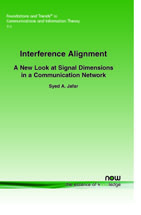Interference Alignment — A New Look at Signal Dimensions in a Communication Network
By Syed A. Jafar, University of California, USA, syed@uci.edu
Abstract
This monograph introduces to the reader the idea of interference alignment, traces its origins, reviews a variety of interference alignment schemes, summarizes the diverse settings where the idea of interference alignment is applicable and highlights the common principles that cut across these diverse applications. The focus is on theoretical aspects.
Interference Alignment
Interference alignment is a radical idea that has recently emerged out of the capacity analysis of interference networks. In a relatively short time, this concept has challenged much of the conventional wisdom about the throughput limits of both wired and wireless networks. The technique is based on the idea that if interference or undesired signals are collectively engineered to occupy as low a dimensional space as possible, the desired signals can be more efficiently conveyed and recovered.
Interference Alignment: A New Look at Signal Dimensions in a Communication Network introduces the concept via a series of simple linear algebraic examples that very effectively convey the central idea of interference alignment. The ideas behind the various communication theoretic instantiations and applications of the technique are illustrated through simple examples that come across as neat little puzzles which enables the reader to quickly understand the topic.
Interference Alignment: A New Look at Signal Dimensions in a Communication Network provides both a tutorial and a survey of the state-of-art on the topic. The numerous concretely stated open problems sprinkled throughout tee up issues for further research for the reader. The presentation style of this tutorial is informal, favoring broad intuition over mathematical rigor and is written to be accessible to graduate students, researchers and professionals working in communication, signal processing, networking or information theory.
